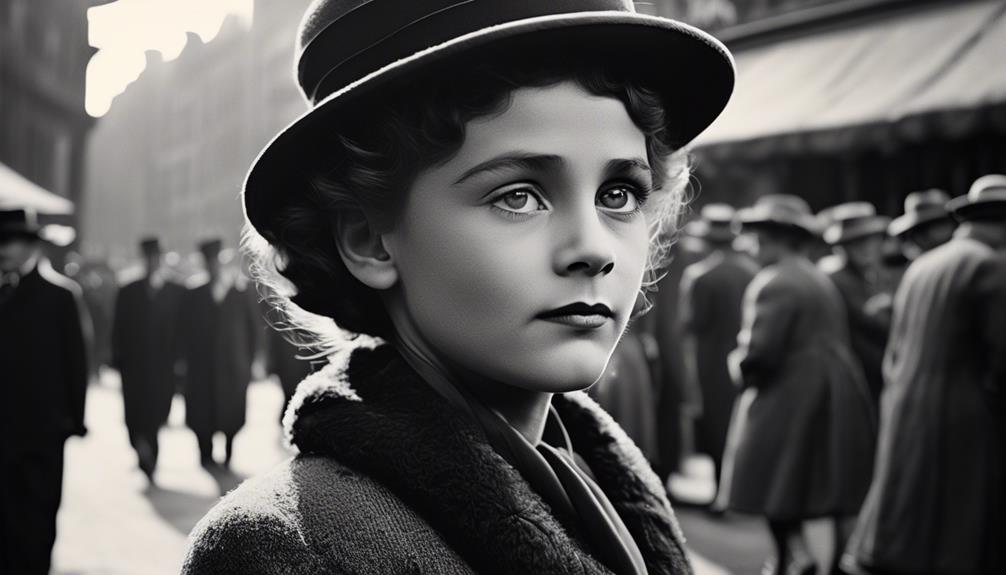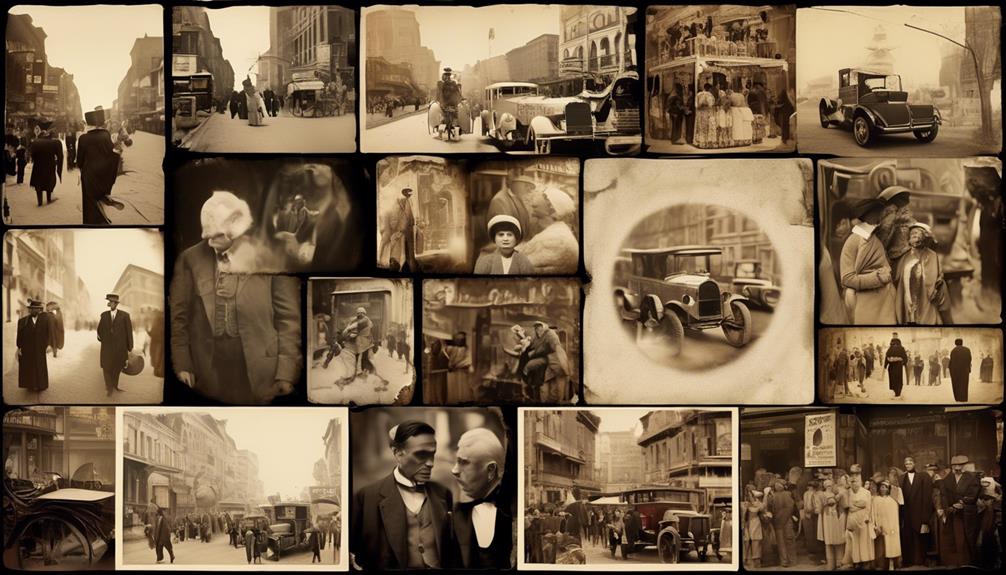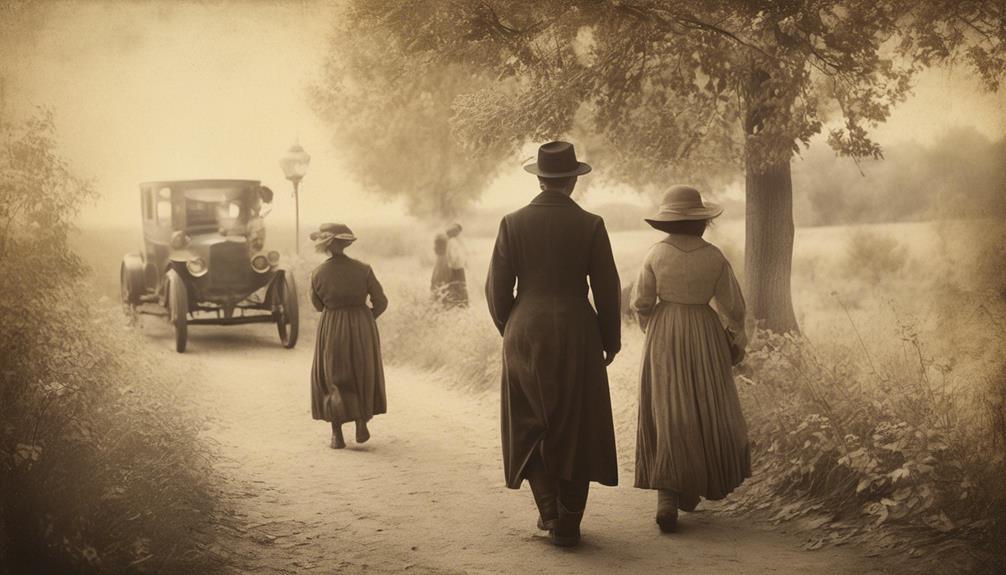Please note this post may contain affiliate links picked by me (Jay) that I have deemed may be of interest or relevant to you the reader of this.
These links do not affect the cost of the thing if you decide to purchase but i may get a little money if you choose to purchase.
For more information on my affiliate link policy click here.
As I explore the fascinating world of photography, I find myself drawn to the rich history of this art form and the movements that have shaped it. From the dreamlike images of Pictorialism to the raw authenticity of Street Photography, there is a wealth of inspiration to be found.
But where to begin? In this discussion, I will introduce you to nine inspiring historical photography movements that are perfect for beginners like myself. Each movement offers a unique perspective and a chance to explore different techniques and styles.
So, grab your camera and join me on this journey through time and creativity.
Key Takeaways
- Historical photography movements have revolutionized the art form, challenging traditional perspectives and pushing the boundaries of visual storytelling.
- Street photography captures the beauty of everyday life and showcases the diversity of urban exploration.
- Documentary photography serves as a powerful tool for social commentary, authentic visual storytelling, and inspiring change.
- The concept of the decisive moment, pioneered by Henri Cartier-Bresson, emphasizes capturing spontaneous moments that tell compelling stories and evoke emotions.
Pictorialism
Pictorialism, a captivating movement in the realm of historical photography, brings to life a dream-like quality through the masterful manipulation of light and composition. It was a rebellion against the rigid conventions of traditional photography, introducing innovative techniques that explored aesthetics in new and exciting ways.
Breaking traditional norms, pictorialists embraced unconventional subjects, such as landscapes, portraits, and still lifes, and transformed them into ethereal works of art. They manipulated light and used soft focus techniques to create a sense of mystery and emotion, blurring the lines between photography and painting.
One of the key elements of pictorialism was the deliberate use of composition to evoke a certain mood or atmosphere. Photographers carefully arranged elements within the frame, paying attention to lines, shapes, and textures. By doing so, they were able to create visually striking images that went beyond mere representation.
Pictorialism was about pushing the boundaries of what was considered acceptable in photography. It encouraged artists to experiment with different printing techniques and to embrace the imperfections that came with them. This willingness to take risks and challenge the status quo paved the way for future generations of photographers to explore their own creativity and strive for innovation.
Straight Photography
Exploring the realm of historical photography, the movement of Straight Photography revolutionized the art form by capturing raw and unfiltered moments with a focus on realism and truth. Straight Photography emerged in the early 20th century as a response to the highly manipulated and stylized approach of Pictorialism. It sought to capture the world as it truly appeared, free from artificiality and embellishment.
In Straight Photography, aesthetics were found in the ordinary and mundane, with photographers believing that beauty could be discovered in the everyday. By embracing simplicity and directness, they aimed to convey the essence of their subjects without any alteration or manipulation.
Key characteristics of Straight Photography include:
- Realism: Straight photographers aimed to represent the world as it truly appeared, without any subjective interpretation or manipulation.
- Candid Moments: The movement focused on capturing unposed and spontaneous moments, revealing the authenticity of the subject.
- Sharp Focus and Detail: Straight photographers employed sharp, clear focus and fine details to enhance the sense of realism and precision in their images.
Straight Photography paved the way for modern documentary and street photography and continues to inspire photographers today. By capturing reality in its purest form, Straight Photography celebrates the beauty and truth of everyday life.
Surrealism
After capturing the world in its raw and unfiltered form through Straight Photography, it's time to embark on a surreal journey into the realm of the unexpected and fantastical with Surrealism.
Surrealism is a movement that emerged in the 1920s, fueled by a desire to explore the dreamlike imagery and subconscious depths of the human mind.
Surrealist photographers sought to push the boundaries of reality and challenge conventional ways of seeing. Through their innovative techniques and imaginative compositions, they aimed to create captivating images that were both thought-provoking and visually stunning.
Dreamlike imagery became a hallmark of Surrealism, as photographers manipulated their subjects and environments to evoke a sense of otherworldliness. By blending multiple exposures, distorting perspectives, and juxtaposing unrelated objects, they created a world that was both familiar and unfamiliar.
Surrealism also offered a platform for subconscious exploration. Artists delved into the depths of their minds, tapping into their deepest fears, desires, and fantasies. Through their photographs, they aimed to reveal the hidden aspects of human existence and challenge societal norms.
As a beginner in photography, exploring Surrealism can be an exciting and liberating experience. It allows you to break free from the constraints of reality and tap into your own creative potential.
New Vision
New Vision revolutionized the world of photography by challenging traditional perspectives and pushing the boundaries of visual storytelling. This movement, which emerged in the 1920s, sought to capture the essence of modernity through abstract expressionism and minimalist aesthetics. Its proponents believed that photography shouldn't merely reproduce reality, but rather create new ways of seeing and experiencing the world.
Here are three key characteristics of New Vision:
- Abstract Expressionism: New Vision photographers embraced the principles of abstract art, using unconventional angles, close-ups, and unusual compositions to create a sense of dynamism and energy in their images. By focusing on shapes, lines, and textures, they aimed to evoke emotions and convey a deeper, more subjective understanding of their subjects.
- Minimalist Aesthetics: New Vision photographers sought simplicity and clarity in their work. They stripped away unnecessary details and distractions, emphasizing clean lines, geometric forms, and contrasting tones. This minimalist approach allowed them to create powerful images that captured the essence of their subjects with precision and elegance.
- Experimental Techniques: New Vision photographers weren't afraid to experiment with new technologies and techniques. They embraced the use of wide-angle lenses, multiple exposures, and photomontage to create innovative and thought-provoking images. These experimental approaches pushed the boundaries of traditional photography and opened up new possibilities for artistic expression.
New Vision photographers paved the way for future generations, inspiring them to question the status quo and explore new ways of seeing the world through the lens of a camera. Their bold and innovative approach continues to resonate with photographers today, reminding us of the power of visual storytelling and the endless possibilities that lie within the realm of photography.
Photojournalism
Photojournalism captures the raw essence of reality, bringing important stories to life through powerful images and compelling narratives. As a form of visual storytelling, it plays a crucial role in informing and shaping public opinion. However, it also raises ethical implications that must be carefully considered.
In today's rapidly evolving media landscape, photojournalists face the challenge of balancing the need to capture the truth with the responsibility to respect the privacy and dignity of individuals involved. They must navigate the fine line between documenting events as they unfold and intruding on personal space.
To address these ethical concerns, photojournalists employ various visual storytelling techniques. They use composition, lighting, and timing to create impactful images that convey the emotions and significance of a particular moment. They also rely on captions and accompanying narratives to provide context and enhance the viewer's understanding of the story being told.
Innovations in technology have further expanded the possibilities for photojournalism. With the advent of smartphones and social media, anyone can now become a citizen journalist, capturing and sharing images instantaneously. This has led to a democratization of information, but it also means that photojournalists must find new ways to stand out and make their work resonate in an increasingly saturated digital landscape.
Street Photography
Street photography captures the vibrant energy of everyday life, revealing the beauty and stories that unfold in the streets of our cities. It's a form of photography that allows us to document the world as it is, capturing candid moments and showcasing the diversity of urban exploration.
Here are three reasons why street photography is an exciting and innovative genre:
- Urban Exploration: Street photography takes us on a journey through the concrete jungles of our cities. It encourages us to explore the nooks and crannies, the hidden corners, and the bustling streets that make up the urban landscape. Through our lens, we can discover the beauty in the ordinary and the extraordinary in the mundane.
- Candid Moments: Street photography is all about capturing authentic and unposed moments. It's about freezing time and preserving the emotions, expressions, and interactions that happen in the blink of an eye. These candid moments tell stories, convey emotions, and capture the essence of the human experience.
- Innovation: Street photography is a constantly evolving genre. It pushes us to experiment with different techniques, perspectives, and styles. It challenges us to see the world in a unique way and to capture moments that might otherwise go unnoticed. With the rise of social media and smartphone photography, street photography has become even more accessible and widespread, allowing for new and innovative approaches.
Documentary Photography
As we continue our exploration of different photography movements, let's now turn our attention to the captivating world of documentary photography. This genre of photography is all about capturing real-life moments and telling compelling stories through images. Documentary photography has the power to create social commentary and evoke emotions in viewers. It goes beyond just capturing pretty pictures; it delves into the heart of human experiences, shining a light on important issues and events.
One of the key aspects of documentary photography is visual storytelling. It allows photographers to use their images as a medium to convey narratives and draw attention to social injustices or significant historical events. Through this form of photography, photographers can bring attention to important causes, raise awareness, and inspire change.
To give you a better understanding, let's take a look at a table that highlights the main characteristics of documentary photography:
| Characteristics | Description | Examples |
|---|---|---|
| Social Commentary | Reflects on social issues and challenges | Dorothea Lange's "Migrant Mother" |
| Visual Storytelling | Conveys narratives through images | James Nachtwey's war photography |
| Authenticity | Captures real-life moments without manipulation | Sebastião Salgado's "Workers" |
Documentary photography is a powerful tool for bringing attention to important stories and making a difference in the world. It allows photographers to document history, challenge societal norms, and inspire change through visual storytelling. So grab your camera and start capturing the world around you, because your images have the potential to make a real impact.
The Decisive Moment
Capturing the perfect moment can be a photographer's greatest triumph and an essential element of compelling storytelling. In the world of photography, there's a concept known as 'The Decisive Moment.' This idea, popularized by the influential photographer Henri Cartier-Bresson, emphasizes the importance of capturing spontaneous moments that convey the essence of a scene or subject.
To truly understand and explore the power of spontaneous captures, it's essential to analyze Henri Cartier-Bresson's influence. Cartier-Bresson, considered the father of modern photojournalism, believed that photography should capture the fleeting moments that define a situation. He often referred to this as the 'decisive moment,' where all the elements of a scene come together harmoniously, creating a visually striking image.
The Decisive Moment approach requires photographers to be observant, patient, and quick to react. It involves a deep understanding of the subject matter and the ability to anticipate and capture the most impactful moment. By embracing this philosophy, photographers can create images that not only freeze a moment in time but also convey a story and evoke emotions.
In today's fast-paced world, where innovation and creativity are highly valued, exploring the concept of the decisive moment can lead to groundbreaking and compelling photography. By mastering the art of spontaneous captures and analyzing the influence of Henri Cartier-Bresson, photographers can create images that not only document reality but also serve as powerful and thought-provoking visual narratives.
The New Topographics
Now let's shift our focus to 'The New Topographics', a groundbreaking movement in photography that redefined how we see the world around us. This movement emerged in the 1970s, at a time when urban landscapes were rapidly transforming and the environmental impact of human activity was becoming increasingly evident.
The photographers of 'The New Topographics' sought to capture the changing face of modern cities and the impact of human intervention on the natural environment. They moved away from the traditional notions of landscape photography, which often depicted idyllic scenes untouched by human hands. Instead, they focused on the urban landscapes that were shaped by human activity, documenting the sprawling suburbs, industrial sites, and commercial developments that were becoming increasingly prevalent.
Through their imagery, 'The New Topographics' photographers aimed to highlight the environmental consequences of urban expansion. They captured scenes of suburban sprawl, industrial pollution, and the encroachment of man-made structures on natural landscapes. Their photographs served as a visual critique of the unsustainable practices that were leading to the degradation of our environment.
'The New Topographics' movement challenged the traditional conventions of landscape photography and paved the way for a new approach to capturing the world around us. By focusing on urban landscapes and their environmental impact, these photographers brought attention to the urgent need for sustainable development and a more mindful approach to our surroundings. Their work continues to inspire photographers and viewers alike to consider the consequences of our actions on the environment.
Frequently Asked Questions
What Are Some Famous Photographers Associated With the Pictorialism Movement?
Some famous photographers associated with the pictorialism movement include Alfred Stieglitz, Edward Steichen, and Clarence White. They were pioneers in the early 20th century, using photography as a means of artistic expression.
Through soft focus, manipulated prints, and dreamlike compositions, they aimed to blur the lines between photography and painting. Their work challenged traditional notions of photography and inspired future generations of photographers to push the boundaries of the medium.
Their impact on the art world is still felt today.
How Did the Surrealism Movement Influence the Use of Photography as an Art Form?
The Surrealism movement had a profound impact on the art of photography. It revolutionized the way photographers approached their craft, pushing boundaries and challenging traditional norms.
Surrealism encouraged artists to explore the subconscious mind, dreams, and the irrational, leading to the creation of visually stunning and thought-provoking images. Through techniques like double exposure and photomontage, photographers were able to create surreal and otherworldly compositions.
Surrealism's influence on photography continues to inspire and shape the way we capture the world today.
What Techniques Are Commonly Used in Straight Photography?
In straight photography, the emphasis is on capturing subjects as they are, without any manipulation or alteration. This technique highlights the pure essence of the subject, allowing viewers to see the world through the photographer's lens.
Elements of composition, such as framing, lighting, and perspective, play a crucial role in creating captivating images. By mastering these techniques, beginners can create powerful and authentic photographs that evoke emotion and inspire innovation in the world of photography.
How Did the New Vision Movement Challenge Traditional Photography Composition?
The new vision movement brought exciting challenges to traditional photography composition. It encouraged photographers to think outside the box and explore alternative perspectives. By breaking away from conventional rules, this movement pushed the boundaries of what was considered acceptable in photography.
It embraced abstract and surreal elements, creating visually stunning and thought-provoking images. The new vision movement inspired a whole new generation of photographers to experiment and innovate, forever changing the way we see and capture the world through our lenses.
What Role Did the New Topographics Movement Play in Shaping Modern Landscape Photography?
The New Topographics movement played a pivotal role in shaping modern landscape photography. By challenging traditional notions of the picturesque and embracing a more objective approach, photographers were able to capture the raw and often overlooked beauty of the urban landscape.
This movement was greatly influenced by advancements in technology, allowing for a more detailed and realistic depiction of the environment. The impact on documentary photography was profound, as it encouraged a more critical examination of our surroundings and the impact of human intervention.
Conclusion
After exploring these inspiring historical photography movements, it's clear that the power of imagery transcends time.
From the dreamlike surrealism to the raw reality of photojournalism, each movement showcased the unique perspective of the photographer.
By immersing ourselves in these artistic journeys, we can gain a deeper appreciation for the art of photography and find inspiration for our own creative endeavors.
So grab your camera, step into the footsteps of these pioneers, and capture the world with your own unique lens.


